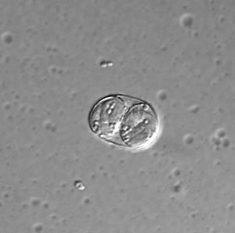Host Environment
T. gondii lives inside mammal hosts for the vast majority of its life. Its secondary host, the cat, is where it competes the sexual stage of it's life cycle. Once inside the cat, T. gondii sporozoites enter intestinal epithelial cells. From there it likes to spread to other parts of the cats body. It lives in the musculature, brain, lymphatic system, and virtually every cell it can get into (7).
T. gondii oocysts are excreted in cat feces. Once
dropped into the outside environment they can live for many years (8).
Other mammals that are infected by eating things contaminated with oocyst cat feces serve as intermediate hosts for T. gondii. When inside an intermediate host, T. gondii will move into the lymphatic system. It will encyst in the musculature, brain, and intestinal tissues. It will blast its way into any cell in the body (7).
T. gondii is worldwide in distribution. It is estimated that over 50% of the human race is infected. Some areas of Europe show over 90% infection (8).
The environment of Toxoplasma gondii cycles between cat feces, and any kind of mammal that comes into contact with this organism. However, its life cycle is only finished once it gets into the environment of a cat (6).
Top | Nutrition | Home | Life Cycle
